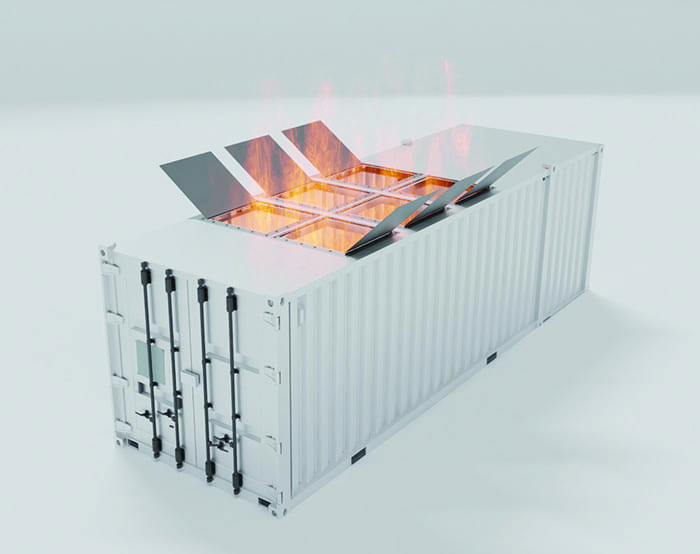Lithium-ion battery energy storage systems (BESS) have emerged as a key technology for integrating renewable energy sources and grid stability. However, the significant energy density in a confined space poses fire risks. Recent incidents have highlighted the need for effective interventions to detect and mitigate BESS failures before they escalate into catastrophic events. This article explores the causes of fires in storage (BESS) systems and key interventions, including specialist fire suppression, to ensure safe operation of facilities.

Causes of BESS fires:
There are several factors that contribute to fire in BESS storage systems. Some of them are:
Battery cell design and quality: Poor battery cell design or manufacturing defects can lead to internal short circuits and thermal runaway.
Overcharging and overheating: Charging BESS batteries beyond safe limits or exposing them to excessive heat can cause thermal compromise.
External heat sources: Fires near BESS facilities can lead to thermal hazards and escalate into thermal runaway.
Containment Design: Inadequate enclosure design fails to contain flammable gases and withstand external heat sources.
Therefore, to ensure the safety and reliability of BESS storage facilities, the following best practices should be implemented:
Battery Management System (BMS):
A well-designed and constructed battery management system serves as the primary defense against potential system failures. The BMS continuously monitors battery operations and operating conditions, ensuring that batteries remain within safe parameters. In the event of anomalies, the BMS immediately shuts down the faulty cells, preventing thermal runaway and mitigating safety risks.
Gas detection system:
To further enhance early intervention, a gas detection system should be installed. This system can quickly detect the release of flammable vapors, signaling possible battery failure before smoke is generated. If a gas is detected, the system can trigger mitigation actions such as shutting off power to affected cells, activating ventilation systems, and sounding an alarm to alert operators and first responders.
Fire suppression system:
A total immersion concentrated aerosol fire suppression system is recommended for BESS facilities. Traditional fire suppression agents may be ineffective against BESS fires, but condensed aerosol agents such as Stat-X have been shown to be effective in rapidly suppressing fires, limiting the spread of thermal escape, and preventing rekindling. This specialized fire suppression medium is designed to address the unique challenges posed by BESS incidents.
Safety measures for those responsible:
To ensure the safety of those responsible, additional measures can be implemented, including:
1.Fire Department Quick Connect Dry Pipe Sprinkler or Water Mist System:These systems allow fire crews to cool the inside of the enclosure from the outside, reducing the risk of explosions or further scaling.
2.Thermal imaging cameras: Equipping responders with thermal imaging cameras allows them to detect heat levels and hot spots within the enclosure without direct contact, enhancing situational awareness and response effectiveness.
Protecting lithium-ion battery energy storage systems (BESS) requires a layered and systematic approach. The use of a well-designed battery management system for monitoring, gas detection systems for early warning, and a total immersion concentrated aerosol fire suppression system for rapid fire control are key elements of an integrated protection system. In addition, providing safety measures to the operators in charge, such as quick-connect sprinklers and thermal imaging cameras, enhances their ability to respond safely and effectively to potential BESS incidents. By adhering to these best practices, stakeholders can minimize fire risks and promote the safe and sustainable integration of batteries into modern energy systems.
Sources:
Source: Fire guts batteries at energy storage system in solar power plant (ajudaily.com)
Source: Stages of a Lithium Ion Battery Failure – Li-ion Tamer (liiontamer.com)

